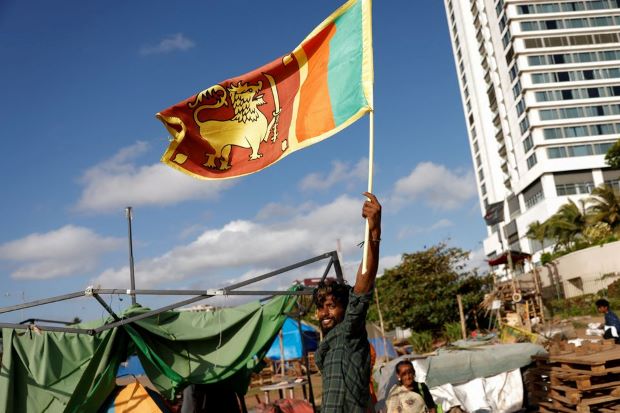A new enemy for the Sinhala Buddhist nationalists
By Sathriyan
Sinhalese Buddhist nationalist forces have once again begun exploiting anti-American and anti-Indian sentiments with an eye on the approaching presidential election. Though the line-up of candidates remains unendorsed at this time, the names of seasoned troupers Ranil Wickremesinghe, Sajith Premadasa, Anura Kumara Dissanayake, Patali Champika Ranawaka, Maithripala Sirisena, Kumara Welgama, Dayasiri Jayasekara, and Sarath Fonseka, are topping the list as likely or willing candidates.
All political parties, except the Sri Lanka Podujana Peramuna (SLPP), have indicated they would be fielding their presidential candidate. The SLPP, it appears, is undecided as to whether to field their candidate or support a candidate from an affiliate party.
Sinhalese nationalist usually strive to become the decisive force, especially in presidential elections, tipping the scale of their chosen candidate. They supported Gamini Dissanayake in 1994, and later Chandrika Bandaranaike Kumaratunga, who went on to win that election, and the re-run in 1999. They contributed significantly to Mahinda Rajapaksa’s victory in 2005 and 2010, and in 2015, though he lost that election. In 2019, they redoubled their efforts and backed Gotabaya Rajapaksa.
With the underlying intention of strengthening Sinhala Buddhist nationalism, these nationalist forces as a rule support candidates who have strong anti-Tamil stances, though there appears to be a re-think since the fall of Gotabaya Rajapaksa, with many of the usual suspects forging their separate paths.
Though the likes of the rabidly nationalist Sarath Weerasekera remain with the SLPP, Wimal Weerawansa and Udaya Gammanpila are running as a separate team, as are several other Sinhala nationalist factions. But the question is, will these factions come together when the election is officially declared, and who will they support? There are also questions about the conditions they might put forward for their support.
When the nationalist factions backed Gamini Dissanayake, Chandrika Kumaratunga, and Mahinda Rajapaksa, they all had a common enemy in the Liberation Tigers of Tamil Eelam (LTTE). They supported Mahinda Rajapaksa during his second term and his bid for a third term to prevent the Tamils from securing their rights post-war and to obstruct justice for war crimes.
They installed Gotabaya Rajapaksa as president based on his wartime achievements and to end the perceived threat from Islamic fundamentalists after the Easter Sunday attacks. But significantly they backed him to demonstrate that a Sinhala Buddhist president could be elected without the support of the minority.
Now another presidential election is on the horizon and Sinhala nationalist forces need a strong reason to unite and support a candidate.
Though the election is important for leaders like Ranil, Sajith, and Anura for various reasons, no single candidate can use an anti-Tamil stance as a central theme in their campaigns. Not in today’s environment. On the flip side because the LTTE has ceased to exist, the political struggles of Tamils have also tapered, and corollary pressures to account for war crimes have also lessened.
However, the nationalist forces need to unite to demonstrate their strength. Failure to support any side may create the perception that Sinhalese Buddhist nationalism is weakening. No Sinhalese Buddhist chauvinist leader would want to witness a decline in the fervour of Sinhalese Buddhist chauvinism, epitomized so grandly by Gotabaya Rajapaksa’s resounding victory, in just five years. Therefore, they will opt for a candidate who aligns with their policies and can advocate for them or heed their counsel. A comprehensive strategy will be devised to ensure his success, with a probable focus on fostering antagonism against India and the US.
Now that there is no LTTE and no threat from Islamic fundamentalists, anti-India and anti-American sentiments have become conduits for the nationalist forces to conveniently carry their propaganda among the Sinhalese people.
The economic crisis, propelled by unsustainable loans from China, was the main reason for Gotabaya Rajapaksa’s downfall, as was their overtly pro-China stance. China’s predatory behaviour, a case in point being the demand to settle US$ 6.8 million for the rejection of a consignment of contaminated organic fertilizer, didn’t sit well with the public either.
The government has gradually distanced itself from its pro-China stance after Ranil Wickremesinghe’s ascension to power, but at the same time moved closer to India and the US. It was this shift in alliance that helped stem the economic crisis from becoming a total disaster to some extent.
Now India has started investing in massive projects, and the government’s cooperation with the giant neighbour has increased. India recently launched its Unified Payment Interface (UPI) services and the Rupay card in Sri Lanka enabling Indian nationals visiting the country to pay in Indian rupees. Efforts are also being made to connect ports and airports with India, and agreements have already been reached to jointly set up wind and solar power plants. All this has created fears about India’s expansion.
Similarly, the United States increase has also increased its economic footprint, and recently offered to invest more than $500 million in the Eastern Container Terminal.
Nationalists have been fearmongering about India’s plans to annex Sri Lanka as its 26th state when it had 25 states, and now Sarath Weerasekara is drumming the same beat saying Sri Lanka cannot be allowed to become India’s 29th state.
Ill-phrased comments by Tourism Minister Harin Fernando in Mumbai to the effect that Sri Lanka is becoming a part of India, have been fodder for people like Wimal Weerawansa and Udaya Gammanpila, who accuse him of selling the country’s sovereignty. Demands have also been made in Parliament that Fernando should be sentenced to death for treason.
Recent US criticism of the Online Safety Act and other suppressive laws have also angered the Sinhalese nationalists.
All these are opportunities for the rabid Sinhala Buddhist Nationalists to use anti-Indian and anti-American sentiments to their advantage in the presidential election. And even if it is too premature to identify a candidate, it seems they have identified the tools they will be using to build the base for their candidate.
-ENCL



Comments are closed, but trackbacks and pingbacks are open.